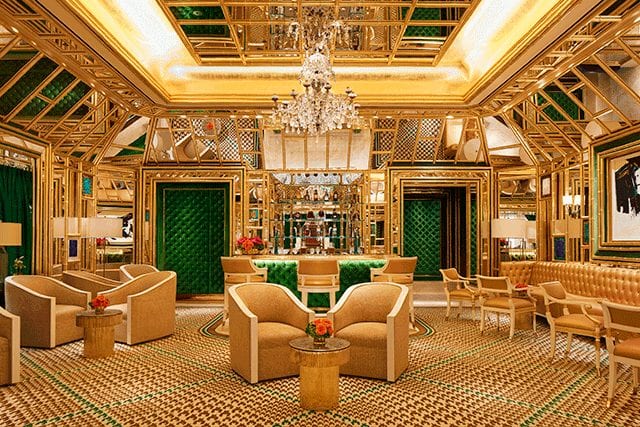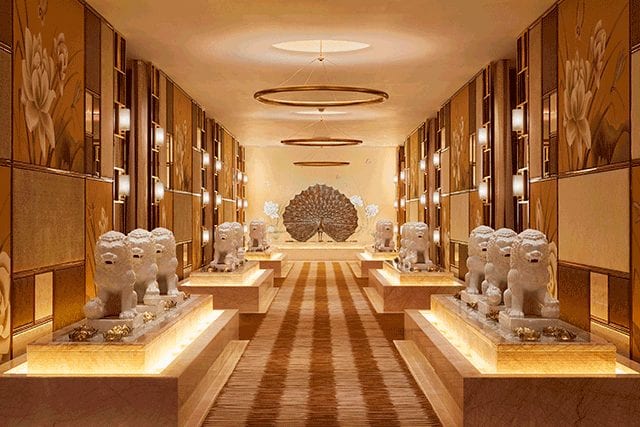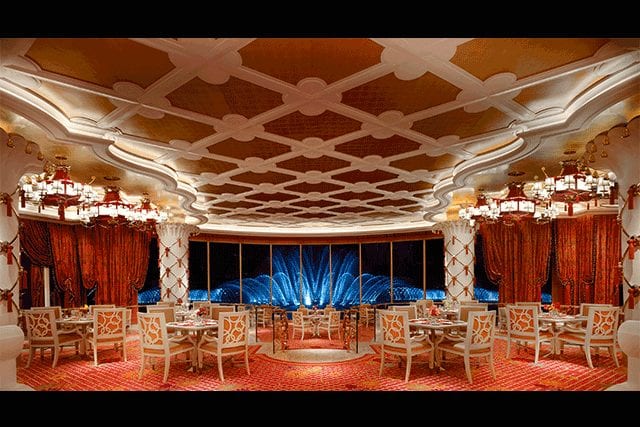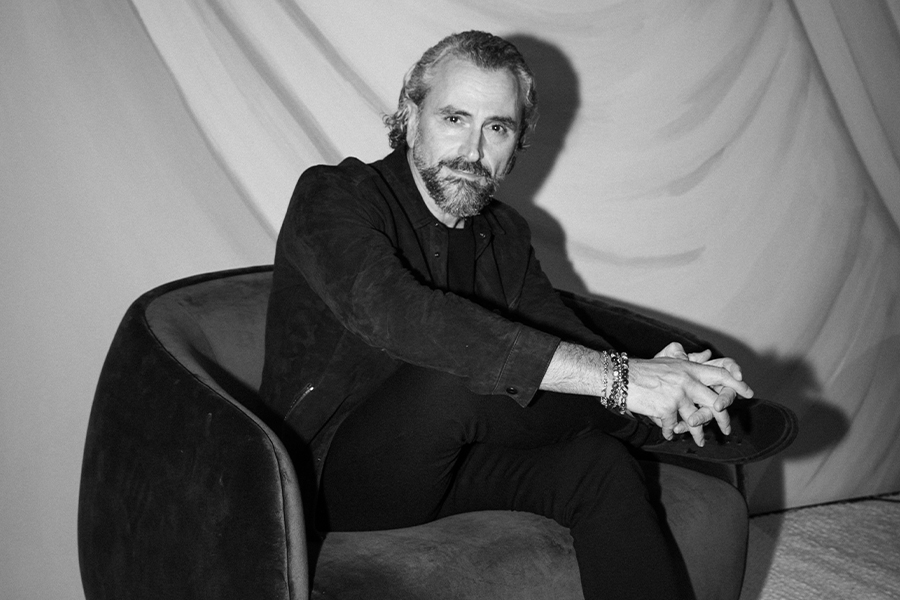For the lavish and floral-themed Wynn Palace Cotai in Macau, the brand’s executive vice president of design Roger Thomas was once again called on to transport guests into a world of luxury, beauty, and entertainment. Indeed, crafting the world’s biggest resort isn’t easy, and after six years and $4.2 billion, the opulent mega-property has finally opened it doors, boasting 1,706 rooms, an eight-acre Performance Lake and fountain show (choreographed to the resort’s signature song “Elegance”), a rooftop garden that overlooks the South China Sea, air-conditioned gondolas, and, at its center, more than 200,000 square feet of luxury retail space. Not to mention a $125 million art collection that includes showstoppers like the 3-ton stainless steel “Tulips” sculpture by Jeff Koons and a quartet of Qing Dynasty vases.

The gold and jade toned Wing Lei Bar at the Wynn Palace Cotai.
Each moment in the resort is glitzier and more glamorous than the next: a carousel and Ferris wheel by floral designer Preston Bailey in the north and south lobby atriums are fabricated from more than 100,000 real flowers, for one. And Thomas couldn’t do it alone. For F&B, public spaces, retail, and more, he worked alongside highly sought-after firms, including Rockwell Group (Andrea’s, Hanami Ramen, and Sweets patisserie); Vicente Wolf Associates (Mizumi and Noodles 99); TAL Studio (SW Steakhouse along with the spa, salon, spa retail, and pool area); and Peter Marino, who was behind the masterful Chanel store.
We talked to Thomas about reinventing chinoiserie, collaborating with friends, and working with peacock feathers.
What did the robust budget allow you to create?
This is the healthiest budget ever given to a hotel designer. But it’s still a budget. And with a healthy budget, comes the healthiest expectation. If anything, for me, it means that you’re creating more layers, more detail—that you can’t let up your attention. It’s not that you just get to buy more expensive things.

A peacock waits at the end of a corridor at the spa, designed by TAL Studio.
How was collaborating on this project with your protégé Alex Woogmaster, creative director at Wynn?
We always create better in dialogue than we do in a closed room all by ourselves. It’s always much more energetic, engaging, and productive. Alex, who entered our office at about the same time [as the project], and who, like me, is a student of the history of art and architecture, was equally inspired and created some really extraordinary and original moments in the hotel. I’ve said this many times so I don’t care who knows it: He’s better at 29 than I was at 49.
How did you approach this project?
We were asked to honor China and so we decided to reinvent chinoiserie for the 21st century. Really a handful of decorative elements that came to Europe inspired one of the most important design influences of 200 years in the 17th, 18th, and 19th century. It established this kind of romantic charm, and we have the advantage of reinventing chinoiserie in the 21st century with the internet, with extraordinary scholarship, and with the world travel that I’ve been able to do to look at collections and be inspired.
What are some of the challenges of designing in China?
It takes a lot of learning and a lot of sensitivity and a lot of interactions with those who are innovating the way guests are accommodated in China. It’s a culture that is becoming more sophisticated very quickly. One cannot design hospitality in China on assumptions. You can only design it on a real effort to learn and to ask questions, and then ask more questions, and then ask some more. [For instance], there are walls covered in real peacock feathers. I didn’t know if that was good or bad. It’s luxurious and lustrous and exquisite. Thankfully, they have to do with wealth and abundance, so they’re good. But as many questions as we asked, after we opened we had a few discoveries.
What other fun, lavish materials did you use?
The registration desk in the VIP registration area is done in real lapis lazuli inlaid with mother of pearl because just lapis lazuli isn’t enough. [Laughs] And malachite, rare emerald green onyx, tiger eye, rock crystal, lots of gilding and ormolu, and polished brass everywhere.

A gilded red cherry tree is a focal point at Mizumi from Vicente Wolf Associates.
How do you approach a project of this scale?
We get to build a full-scale model of every guestroom and every suite in Las Vegas. We get to hammer on it for two or three years, testing ourselves. We have a great time with trying different fabrics, different carpets, different paint colors, and different light fittings.
We also build a full-scale model of our casino. And that gets beat up, and visited, and used and reused, and reevaluated. While we were designing, the hotel gaming regulations changed, restaurant regulations changed, room regulations changed, code regulations changed. Macau is a fast-paced, growing area with an amount of construction that engenders constant bureaucratic scrutiny and reevaluation, and we had to participate in all of that.
When rethinking the guestrooms and suites, what did you do differently?
We’ve always excelled at guest comfort and convenience, but we were able to take it a step further. Every single drawer you open is completely fitted with whatever goes in it. If there’s a stemware glass, it’s nestled in a suede receptacle of exactly its dimensions—and that goes for every teacup, every sugar packet. We got really maniacal in drilling down to your expectations of opening drawers and finding exactly what you need inside of them. Along the way, I completely reinvented a line of plumbing because I don’t want anybody to see anything that’s in there and say, ‘Oh, look, that’s just like when we were staying at…’ It can be the most elevated reference in the world, but it still doesn’t make it a unique set of dramatic experiences, which is what I want.
Of all the standouts, what are some of your favorite moments at the hotel?
Creating our two most opulent restaurants and a bar: Wing Lei Palace and Wing Lei Palace Bar, and Café Fontana. They were absolutely the greatest flights of fancy that we got to take and great fun. We have a fountain in the front yard that makes Bellagio look like our training wheels. Bellagio was just a learning experience to allow us to do this fountain.

The windows at Café Fontana perfectly frame the resort’s fountain show.
What can you tell us about the Wynn Boston Harbor, set to open in 2019?
It’s just north of downtown on the Mystic River, and it’s going to be beautiful. Alex is taking the lead; I’m the éminence grise for this project. It’s a new expression in casino design that we haven’t done before but will have some of our favorite Wynn amenities.
What’s next for you?
It’s time to redo much of what we’ve already done. So we’re reinventing spaces. We’ve got an enormous new race and sports book restaurant coming into Wynn Las Vegas. We’re reinventing a new gaming area for Encore Las Vegas. We’re adding the Wynn Plaza retail esplanade in Las Vegas. It’s constant and forever. We’re completely rethinking our Italian restaurant at Wynn Macau. We’re the painters of the Golden Gate Bridge—the minute we get done, we have to start over.


